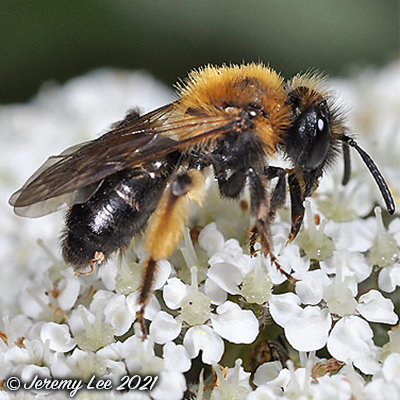
 |
|
Scientific Classifications explained » Amphibians » Ants » Aphids » Bees » Beetles » Birds » Bugs » Butterflies » Caterpillars » Damselflies » Dragonflies » Earwigs » Flies » Frog/Leafhoppers » Fungi » Galls » Grasshoppers » Harvestmen » Hoverflies » Lacewings » Ladybirds » Leaf Mines » Lichens » Mammals » Millipedes » Mosses » Moths » Sawflies » Slugs » Snails » Spiders » Trees & Shrubs » Wasps » Wild Flowers » Woodlice » Postboxes |
; ?>
UK Nature > Bees > Andrena bicolor

Scientific Name: Andrena bicolor Common Name: Mining Bee Andrena bicolor is a small, solitary mining bee. The females are about 9 to 11 mm, and the males are slightly smaller. It is very similar in appearance to several other members of the genus and detailed examination is required in order to arrive at a sound identification. This species has black hairs on the face, gingery hairs on the thorax and a blackish abdomen with pale hairs between the segments. It has two generations per year, being on the wing from March to May and then from late June to August. They nest in the ground, usually where the soil is quite soft. A small nest is constructed containing a few cells, which the female fills with pollen. A single egg is laid in each cell and the larvae feed on the pollen. They can be found in various habitats including grassland and open woodland areas. Fairly frequent and found throughout Britain, though mostly in southern parts. |
|

https://www.uknature.co.uk is a website dedicated to showing the immense diversity of UK nature and wildlife. Our vast range of habitats, from lowland arable to snow covered mountains, from storm-ravaged coastlines to peaceful inland freshwater lakes and rivers, from dry, sandy heaths to deciduous and coniferous forests, all these habitats contribute to the abundance of UK nature. We have wild birds in huge numbers either residing or visiting our shores (597 recorded species as at July 2013) and we must also not forget the humble back garden with its grass lawns, flower beds filled with nectar rich flowers, shrubs and trees, all designed to attract huge numbers of insects such as bees, moths, butterflies and hoverflies; and finally the small ponds which provide safe havens for frogs, toads, newts and even slow worms and grass snakes. www.uknature.co.uk is the showcase for my personal passion, photographing uknature in all its glory. I sincerely hope you all enjoy the fruits of my labours. This site and all images contained therein is © Jeremy Lee 2004 - 2025. All Rights Reserved. Site design by Jeremy Lee. Site development & IT Support by Stuart Lee. |